This post may contain affiliate links. Please read my disclosure policy.
Hunan Shrimp is a hot and spicy shrimp dish packed with flavor from chili bean paste, garlic, soy sauce, and rice vinegar. The spicy plump shrimp are served with blistered green beans and green onions, and served over sticky brown rice. Ready in 20 minutes or less!
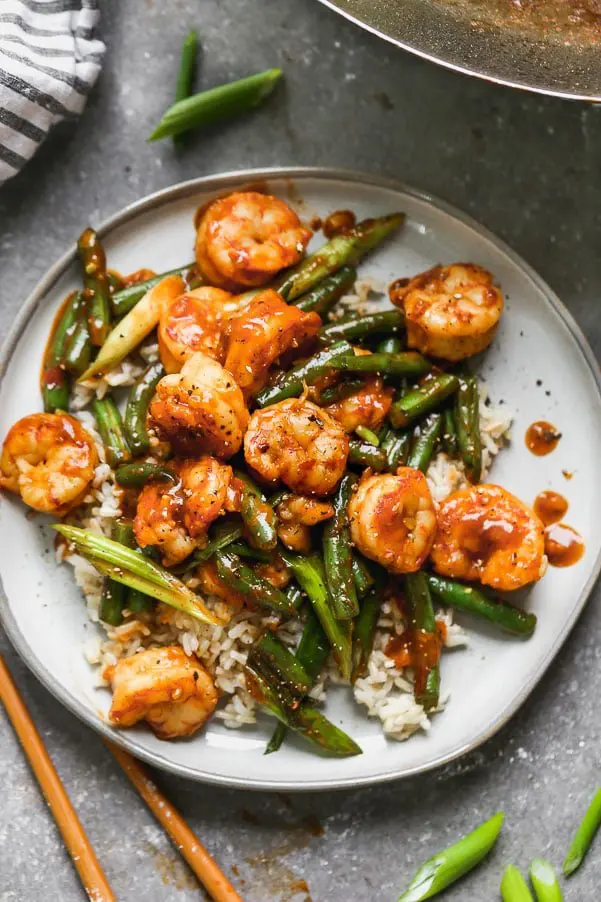
Hunan Shrimp
You may be asking yourself, “Does this girl ever get tired of eating Asian food?” That answer is a big, resounding, “Never!” There’s a reason a variety of Asian recipes like this Thai Peanut Chicken Salad these Teriyaki Chicken Bowls and this General Tso Shrimp seem to be compounding themselves in the recipe archives of Cooking for Keeps, and that’s because they’re so darn easy to make. Oh, and they’re delicious too.
Today’s dish of choice is Szechuan chicken’s spicier cousin, Hunan Shrimp. A fiery, saucy, red chili-inspired stir-fry packed with garlic, crispy plump shrimp, and crisp green beans. Because we prefer the shrimp and green beans to be the star of the show, this easy Asian dish is simply paired with steamed brown or white rice (go with brown!).
What is Hunan Shrimp?
There seems to be a lot of confusion out there on what exactly Hunan shrimp is. I was confused as well. There’s so many different styles of cooking when it comes to Asian food, it’s hard to tell them apart. Even more than that Szechuan chicken or shrimp and Hunan Shrimp or Chicken is so similar, it’s nearly impossible to tell the difference. Here’s the knowledge I’ve acquired over time:
- Both Hunan Shrimp and Szechuan Shrimp are made with a fermented red chili paste, I like to use Doubanjiang (the main ingredient in our Ants Climbing a Tree.)
- They both have notes of garlic, rice vinegar or sherry, ketchup, and soy sauce.
- Szechuan Shrimp has notes of sweetness with the addition of honey or brown sugar to balance out all the spice.
- Hunan shrimp on the other hand, has no added sweetners, so it’s slightly hotter than Szechuan shrimp.
So in a nutshell, Hunan shrimp is a spicy stir fry made with chili paste, garlic, rice vinegar, and soy sauce. It’s salty, spicy, and most importantly, delicious.
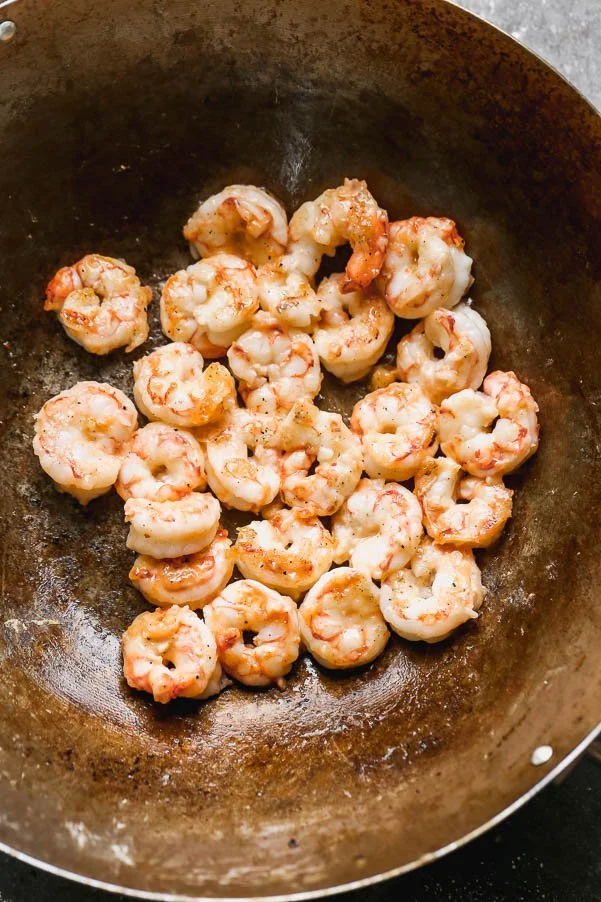
Ingredients in Hunan Shrimp
Shrimp. I’m partial to Argentinean shrimp, which are large and lobster-like in taste and texture, but use whatever shrimp you have available to you. Frozen, fresh, anything works! Just make sure to get one pound total.
Cornstarch. To get a slightly crispy exterior, prior to cooking we dip dry shrimp in cornstarch. We also use cornstarch to thicken the sauce when everything gets cooked together.
Oil. Traditionally you want to use a neutral oil like peanut or canola oil, but I actually like to use sesame oil if I have it on hand. You may not be able to distinguish it in the end, but it adds another layer of flavor in the cooking process.
Green Beans. You could really use any vegetable here, but for me, spicy shrimp + green beans is the perfect duo. I love how the green beans get a little charred on the outside, but still retain their crunch throughout the cooking process.
Green onions. I like to slice my green onions on the bias in about two-inch pieces. I add them right at the end so they start to soften, but still have a slight bite to them.
Garlic.
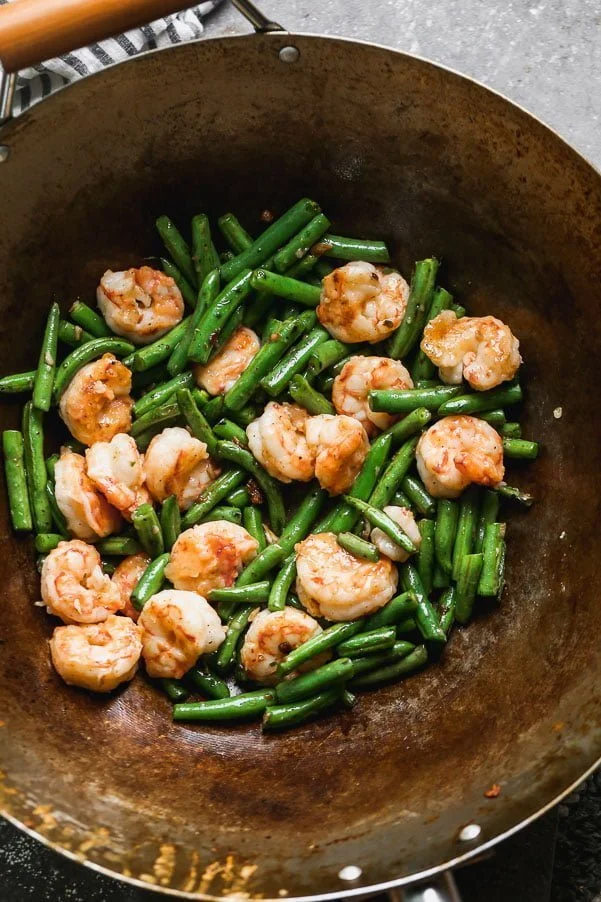
Chili paste. Since Hunan shrimp is a szechuan dish, I stuck with the same chili paste you would use in a traditional szechuan recipe which is a fermented chili bean paste called Doubanjiang. Some grocery stores may have it, but your best bet is to order it on Amazon. If you already have Gochujang or Sambal Oelek in your pantry, you can use those as well.
Tamari. As I’ve mentioned before, tamari is a less salty, more savory, and (most of the time) gluten-free version of soy sauce. I prefer it to soy sauce as I think it adds a richer flavor to dishes, but of course, if soy sauce is all you have on hand, use that.
Chicken stock. Chicken stock creates a more sauce-like texture, use more if you like a loose sauce. Make sure to buy a version that’s low-sodium so you can control the amount of salt that goes into the dish.
Rice vinegar. I love the tanginess rice vinegar adds to this Hunan shrimp. A little goes a long way, but if you taste it, and think it needs more, add a few more teaspoons.
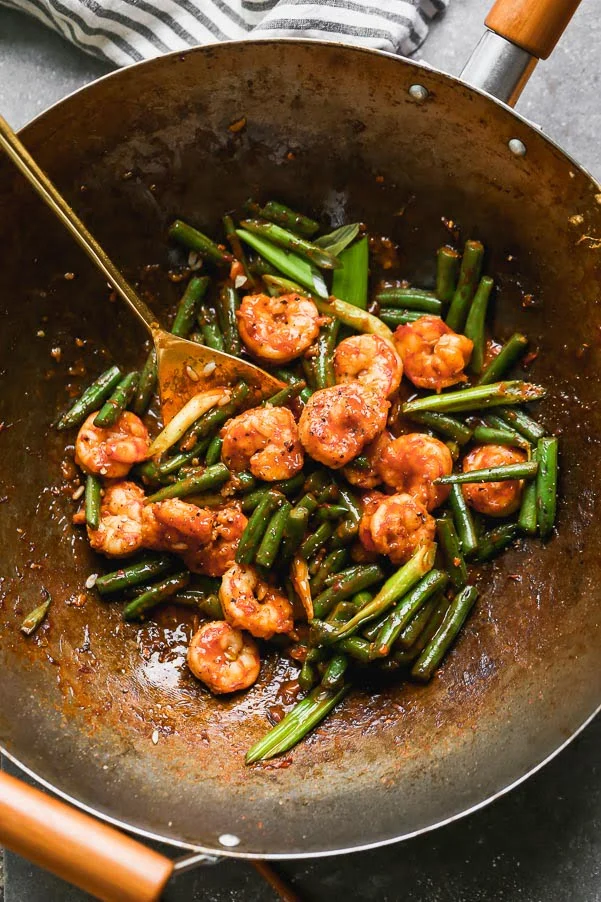
How to Make Hunan Shrimp
Cook the rice. I highly recommend investing in a Rice Cooker. It makes THE MOST PERFECT rice. It’s sticky, fluffy, and cooks perfectly every single time. I love it. It’s one of those appliances I never knew I needed until I had it. Of course, if you don’t have a rice maker, you can just cook short grain brown rice according to the package instructions.
Make the sauce. Add chili paste, soy sauce, rice vinegar and cornstarch to a small bowl. Whisk to combine. Add in chicken stock, whisk to combine.
Coat the shrimp. The shrimp in Hunan shrimp are just slightly crispy, and that’s due to a light coating in cornstarch. Make sure the shrimp are all super dry before seasoning them with salt and pepper and tossing them with a little bit of cornstarch.
Stir-fry the shrimp. Heat a large wok or skillet to a high heat. Add a little bit of oil. Swirl it around in the pan. Add in the shrimp and use a spatula to stir-fry the shrimp until they’re pink and almost all the way cooked through. Remove.
Stir-fry the green beans. Add a little bit more oil to the wok. Swirl it around and add the green beans. Stir-fry until they start to blister and soften, 3-4 minutes. Season with salt and pepper. Add the green onions and stir-fry for another minute.
Finish it off! Add the shrimp back to the wok along with the sauce. Continue to stir the shrimp, veggies, and sauce until the sauce thickens, about 1-2 minutes. Serve over rice.
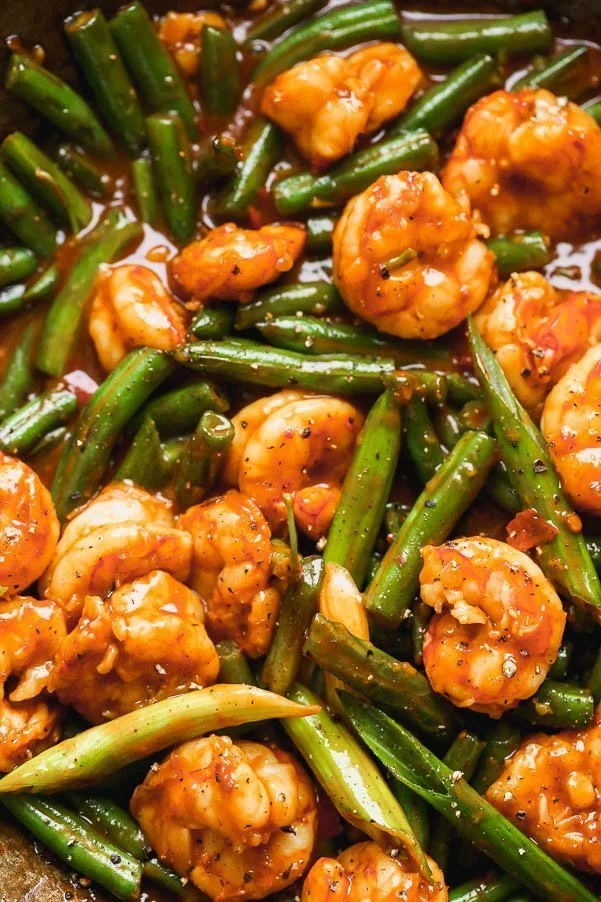
Can I make Hunan Shrimp in Advance?
Unfortunately, no. I wouldn’t recommend making Hunan shrimp in advance. Shrimp do not reheat well, the end.
Substitutions and Tips and Tricks for Recipe Success
- Swap out the shrimp for chicken, to make a classic Hunan Chicken.
- Use any veggie you have on hand instead of green beans. Bell peppers, broccoli, or asparagus would be great substitutions.
- Feel free to use soy sauce instead of tamari
- Use any type of chili bean paste you can find. If you only have sambal oelek or sriracha, you can use that as well.
Pretty things/Tools Used in Today’s Post
Other easy Asian dishes
- These 5-Ingredient Peanut Noodles are made with all pantry staples and come together in about 25 minutes.
- If you’re looking for a beef option, look no further than this Crispy Honey Beef with Snow Peas.
- These Easy Peanut Chicken Lettuce Wraps are one of my favorite healthy asian dishes. Packed with ground chicken, tons of veggies, and the most delicious peanut sauce.
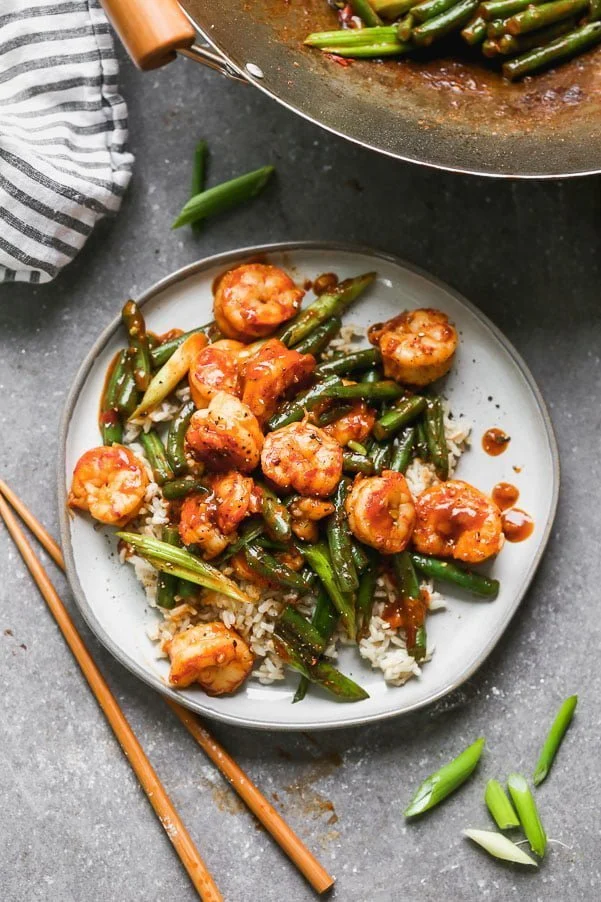
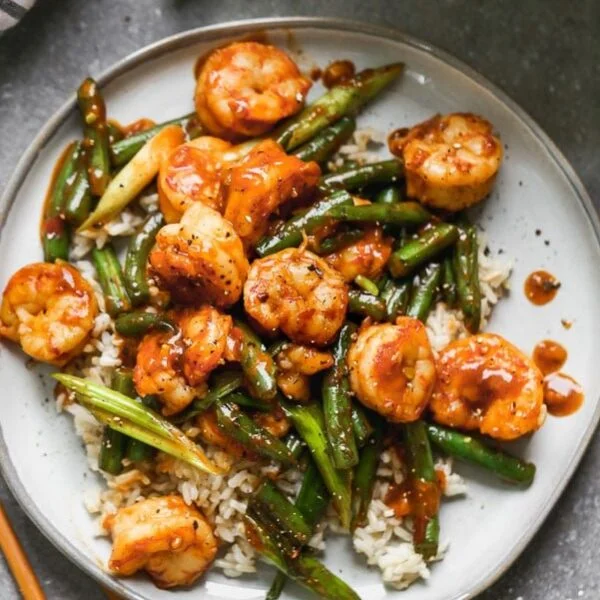
Hunan Shrimp
Ingredients
- 2 tsp Doubanjiang or another chili bean paste
- 2 tsp tamari
- 1 tsp rice vinegar
- 1/2 tsp oyster sauce (no big deal if you don't have this)
- 1 tsp ketchup
- 2 tbsp + 2 tsp cornstarch, divided
- 1/2 cup chicken stock
- 1 lb large shrimp, peeled and deveined and tails removed
- 1 1/2 tbsp canola oil, divided
- 2 cups chopped fresh green beans
- 2 large garlic cloves, minced
- 1 cup cooked brown rice, white rice, or noodles
Equipment
Instructions
- Add Doubanjiang, tamari, rice vinegar, oyster sauce, and ketchup to a small bowl. Whisk to combine. Add 2 teaspoons cornstarch, whisk to combine. Add in chicken stock, whisk to combine. Set aside.
- Pat shrimp dry. Season with salt and pepper. Sprinkle with cornstarch on both sides. Heat a a large wok or non-stick pan to a high heat. Add 1 tablespoon of oil and swirl the pan to coat. Add shrimp. Stir-fry (use a spatula to continuously move the shrimp around and cook in the oil) shrimp until pink, about 2-3 minutes. Remove from pan. Set aisde.
- Add remaining oil to the pan, swirl to coat. Add green beans. Stir-fry until they start to blister and soften, about 3-4 minutes. Season with salt and pepper. Add garlic and green onions, cook another minute. Add shrimp back to the pan along with the sauce. Continue to toss the shrimp and veggies in the sauce until it thickend, about 2 minutes. You may need to let it simmer for 30 seconds or so.
- Serve with rice.
Nutrition Information
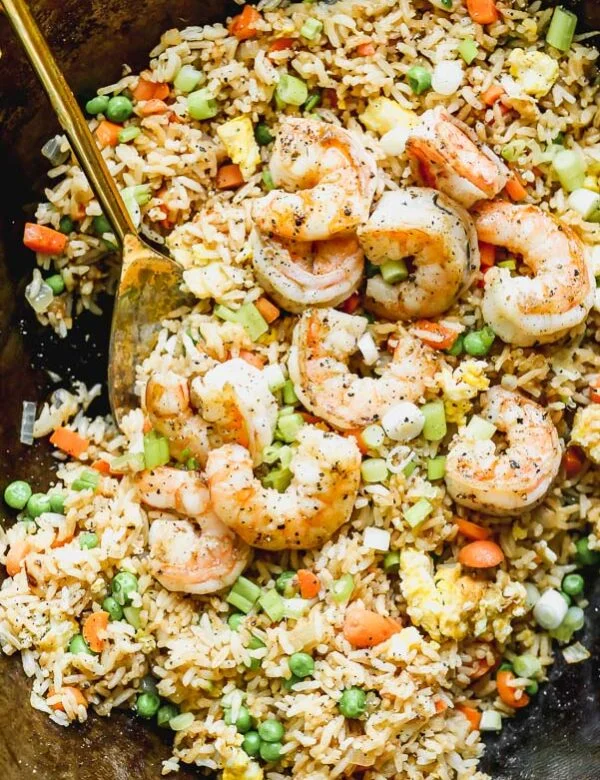
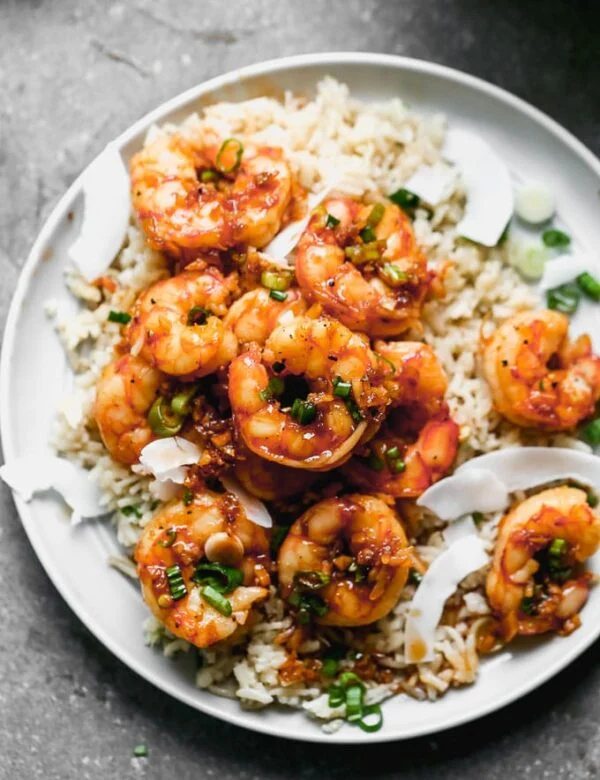
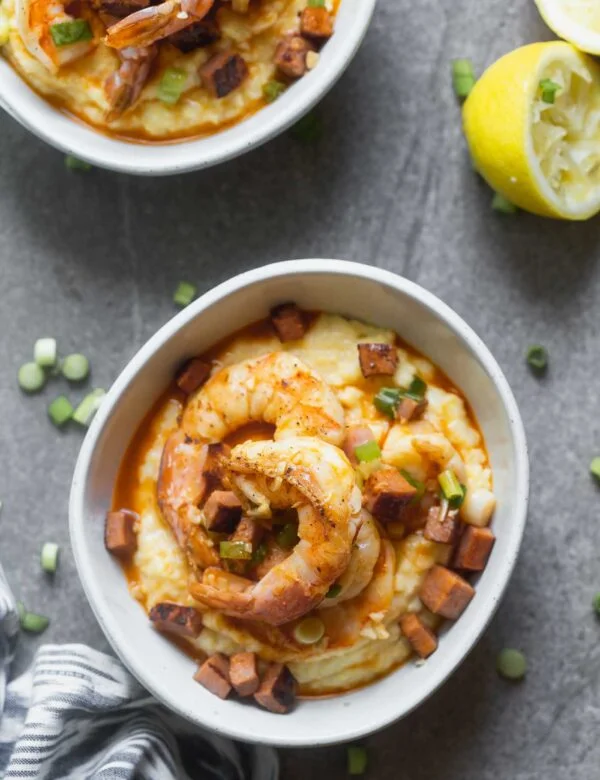
Chef Heather says
Using chickens stock in this recipe is unfortunately a very, very (very!) bad idea. Chef here–NEVER use commercial chicken stock as it’s laced with varying degrees of salmonella.
NEVER use chicken stock with seafood dishes-ever. Either use veggie stock or seafood stock!
Dee Dee says
I’ve been cooking for 42 years and haven’t killed anyone yet by using commercial chicken stock with seafood. Lighten up Heather. The dish is fabulous just as written.
Geo says
Ketchup makes it taste horrible… Should not use that in this recipe.